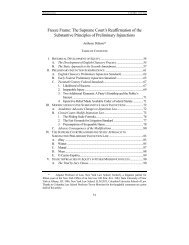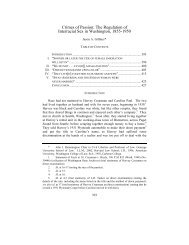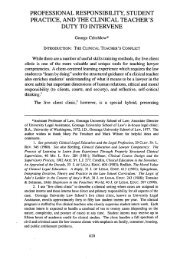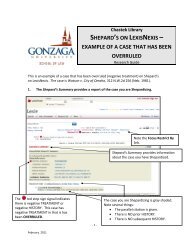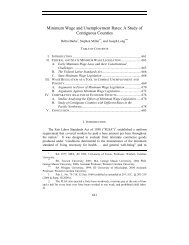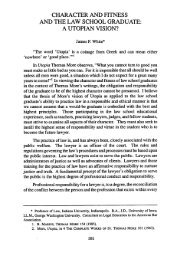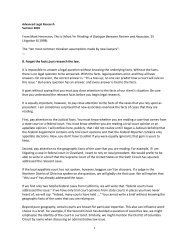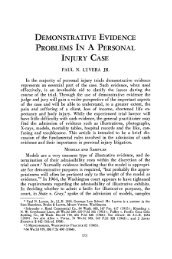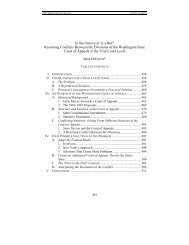I Developments in Washington's Law of Law-Making - Gonzaga ...
I Developments in Washington's Law of Law-Making - Gonzaga ...
I Developments in Washington's Law of Law-Making - Gonzaga ...
You also want an ePaper? Increase the reach of your titles
YUMPU automatically turns print PDFs into web optimized ePapers that Google loves.
2008/09] WASHINGTON'S LAW OF LAW-MAKING<br />
455<br />
about the Weyerhaeuser/WEA test addresses whether an act has "adequately or<br />
correctly set forth the law that it seeks to amend." 312<br />
The court reasoned that article II, section 37 is <strong>in</strong>tended to "ensure that those<br />
enact<strong>in</strong>g an amendatory law are fully aware <strong>of</strong> the proposed law's impact on exist<strong>in</strong>g<br />
law" by requir<strong>in</strong>g that the act or section be set forth at full length. 3 " 3 The court relied<br />
on cases that considered ballot titles and legislative titles 314 under article II, section 19<br />
to determ<strong>in</strong>e that compliance with article II, section 37 is determ<strong>in</strong>ed at the time <strong>of</strong><br />
the relevant legislative action: the operative vote, which <strong>in</strong> this case was the people's<br />
vote. 3 15<br />
For these reasons, the court focused on the voters' understand<strong>in</strong>g <strong>of</strong> the effect <strong>of</strong><br />
the <strong>in</strong>itiative at the time <strong>of</strong> the vote, rather than the date the <strong>in</strong>itiative was filed, <strong>in</strong><br />
order to fulfill the constitutional requirement <strong>of</strong> article II, section 37. The court<br />
determ<strong>in</strong>ed that 1-747 was <strong>in</strong>valid because the <strong>in</strong>itiative before the voters on election<br />
day showed the statute go<strong>in</strong>g from a limit factor generally based on a 2% cap to one<br />
based on a 1% cap (the statutory change made by 1-747 to 1-722) rather than go<strong>in</strong>g<br />
from 6% to 1% (the change to the operative law result<strong>in</strong>g from the <strong>in</strong>terven<strong>in</strong>g court<br />
316<br />
action rather than from a legislative change to the statute). Even though the section<br />
<strong>of</strong> law <strong>in</strong> question was set forth <strong>in</strong> its entirety and even though the <strong>in</strong>itiative text<br />
clearly <strong>in</strong>dicated that if approved the limit cap would be based on 1%, the court<br />
reasoned that because 1-722 had been <strong>in</strong>validated, the change should have been made<br />
to the section as it existed prior to its amendment by 1-722. 3 1 7 In other words, the<br />
section before the voters should have looked like this:<br />
Sec. 2. RCW 84.55.005 and 1997 c 393 s 20 and 1997 c 3 s 201 are each<br />
reenacted and amended to read as follows: ....<br />
(2) "Limit factor" means:<br />
(a) For tax<strong>in</strong>g districts with a population <strong>of</strong> less than ten thousand <strong>in</strong> the calendar<br />
year prior to the assessment year, one hundred ((six)) one percent;<br />
(b) For tax<strong>in</strong>g districts for which a limit factor is authorized under RCW<br />
84.55.0101, the lesser <strong>of</strong> the limit factor under that section or one hundred ((six))<br />
one percent;<br />
312. Id at 495 (emphasis <strong>in</strong> orig<strong>in</strong>al).<br />
313. Idat491.<br />
314. Initiatives to the legislature and referendum bills and measures have both ballot titles and<br />
legislative titles. See <strong>Law</strong> <strong>of</strong> <strong>Law</strong>-Mak<strong>in</strong>g, supra note 8, at 461-62.<br />
315. Wash. Citizens Action <strong>of</strong> Wash., 171 P.3d at 492 (cit<strong>in</strong>g cases).<br />
316. Id.<br />
317. Id. at 492-93,495-96.



